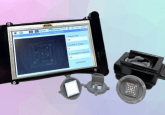Chip-based biosensor to detect cancer biomarker in urine
Researchers funded by the EU’s Horizon 2020 Glass-Laser Multiplexed (GLAM) biosensor program have published a study in The Optical Society journal Optics Letters, reporting a chip-based optical biosensor that detects the cancer biomarker S100A4 in synthetic urine. This sensor could improve the diagnosis and monitoring of cancer.
Previously, biosensing applications have been hindered by complexity and lack of robustness. Recently, a research group led by Sonia Garcia-Blanco from the University of Twente (Enschede, Netherlands), designed a chip-based optical biosensor with an integrated laser that performs label-free detection of the cancer protein biomarker S100A4 in a urine sample.
Garcia-Blanco stated that: “Current methods to measure biomarker levels are expensive and sophisticated, requiring biopsies and analysis in specialized laboratories. The new technology we developed paves the way to faster and ultra-sensitive detection of panels of biomarkers that will permit doctors to make timely decisions that improve personalized diagnosis and treatment of medical conditions including cancer.”
The chip-based optical biosensor aims to provide a non-invasive and inexpensive sensor by illuminating the sample with light from an on-chip microdisk laser, to detect and monitor the progression of cancer. The increased sensitivity of this biosensor is due to the much narrower lasing linewidth compared with the resonances of passive ring resonators in other designs.
The chip-based optical biosensor was tested with synthetic urine containing known biomarker levels. When the light from the sensor interacted with the biomarker of interest, the frequency of the light shifted in a detectable way. The results demonstrated that the sensor was able to detect the cancer protein biomarker – S100A4 – at concentrations as low as 300 picomolar.
Garcia-Blanco explained that: “The biosensor could enable point-of-care devices that simultaneously screen for various diseases. Its operation is simple and does not require complicated sample treatments or sensor operation, making it an excellent candidate for clinical applications.”
The researchers used photonic material, aluminum oxide, to design the new device. When doped with ytterbium ions, aluminum oxide can be used to fabricate a laser that emits in a wavelength range of 1020–1050 nm, outside the light absorption band of water, thus, enabling the sensor to precisely detect cancer protein biomarkers in a liquid environment.
Garcia-Blanco suggested that: “Although sensors based on monitoring frequency shifts of lasers already exist, they often come in geometries that are not easily integrated on small, disposable photonic chips. Aluminum oxide can easily be fabricated monolithically on-chip and is compatible with standard electronic fabrication procedures. This means that the sensors can be produced on a large, industrial scale. Detection in this concentration range shows the potential of the platform for label-free biosensing. Furthermore, the detection module can be potentially made very simple using the developed technology, bringing it a step closer to the final application outside of the laboratory.”
The researchers are working to incorporate all the relevant optical sources and signal generation components onto the chip to make the sensor even more simple to operate. Also, the researchers aim to develop various coatings that could allow parallel detection of a large variety of biomarkers, such as in gas or liquid mixtures for non-biomedical applications.
Source: de Goede M, Chang L, Mu J et al. Al2O3:Yb3+ integrated microdisk laser label-free biosensor. Opt. Lett. 44(24), 5937–5940 (2019); www.eurekalert.org/pub_releases/2019-12/tos-cos120419.php




